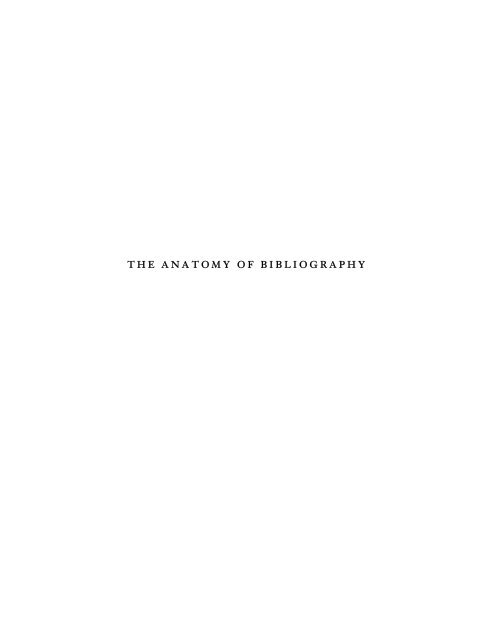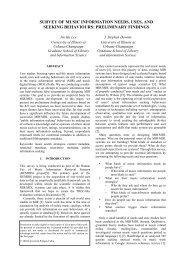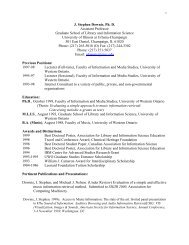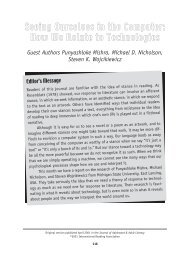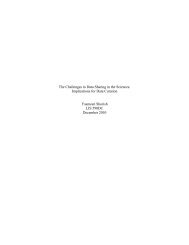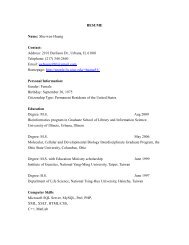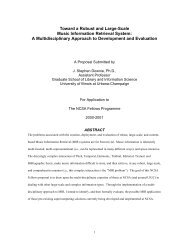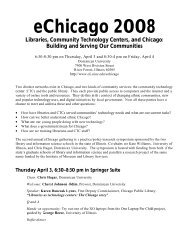The Anatomy of Bibliography - Illinois
The Anatomy of Bibliography - Illinois
The Anatomy of Bibliography - Illinois
You also want an ePaper? Increase the reach of your titles
YUMPU automatically turns print PDFs into web optimized ePapers that Google loves.
THE ANATOMY OF BIBLIOGRAPHY
Frontispiece <strong>of</strong> the 1703 S. Eloi catalogue (see p. 2)
Title page (Sep. 14, 11)<br />
<strong>The</strong> <strong>Anatomy</strong> <strong>of</strong><br />
<strong>Bibliography</strong><br />
An Anthology <strong>of</strong> Perspectives<br />
D. W. KRUMMEL<br />
[ IMPRINT ]
Sources (Sep. 14, 11)<br />
Table <strong>of</strong> Contents<br />
Sources ...................................................................................................................................................................................................................... viii<br />
F OREWORD: Boccaccio and the Angel ......................................................................... [1 ]<br />
THE PREMISES OF BIBLIOGRAPHY<br />
I. Bibliographical Citations .......................................................................................................................................... [9]<br />
Medium. Authority. Readers. Texture (<strong>The</strong> Rhetoric <strong>of</strong><br />
Citation. Unities <strong>of</strong> Scope). Structure. (Organizing the Elements.<br />
Organizing the Entries.)<br />
THE PRACTICES OF BIBLIOGRAPHY<br />
II. <strong>The</strong> Origins <strong>of</strong> <strong>Bibliography</strong> ..................................................................................................................... [39]<br />
III. <strong>Bibliography</strong> as Reading Lists ................................................................................................................ [51]<br />
Trade and National <strong>Bibliography</strong> (Commercial Lists. Trade Lists<br />
and Current National <strong>Bibliography</strong>). Subject Lists (Bio-<strong>Bibliography</strong>.<br />
Subject Lists. Universal and Subject <strong>Bibliography</strong>. <strong>Bibliography</strong> <strong>of</strong><br />
<strong>Bibliography</strong>). Prescriptive Lists (Lists <strong>of</strong> Forbidden Books. Selective<br />
<strong>Bibliography</strong>). Catalogues <strong>of</strong> Collections (Library Catalogues.<br />
Union Catalogues. Exhibition Catalogues. Other Copy-Specific Lists).<br />
E NTR’ACTE: Citations as Comedy ..................................................... [85]<br />
IV. <strong>Bibliography</strong> as Scholarship ......................................................................................................................... [91]<br />
Affection and Trust. Analytical <strong>Bibliography</strong>. Descriptive<br />
<strong>Bibliography</strong>. Textual <strong>Bibliography</strong>. Beyond the Booktrade.
Sources (Sep. 14, 11)<br />
V. <strong>Bibliography</strong> as Cataloguing ........................................................................................................................ [121]<br />
Communities <strong>of</strong> <strong>Bibliography</strong>. <strong>The</strong> Metastasis <strong>of</strong><br />
Bibliographical Practice (Texture. Structure).<br />
Universal <strong>Bibliography</strong>.<br />
VI. <strong>Bibliography</strong> as References .............................................................................................................................. [157]<br />
Footnotes (Structure: Responsibility, Etiquette, and Legal Immunity.<br />
Texture: Citation Practices). Implicit and Informal Citations<br />
T UTORIAL: Bibliographical Searching ....................................................................... [173]<br />
THE POLITICS OF BIBLIOGRAPHY<br />
VII. <strong>The</strong> Dialectics <strong>of</strong> <strong>Bibliography</strong> ................................................................................................................ [187]<br />
Bibliographies as Argument. Bibliographies as Catalysts<br />
C ASE S TUDY: <strong>The</strong> Literature <strong>of</strong> Printing .......................................... [203]<br />
VIII. <strong>Bibliography</strong> as Chronicle ............................................................................................................................... [213]<br />
Iwinski Revisited (Bibliographies. Booktrade Statistics. Expertise.<br />
National Summaries). Beyond Iwinski. (Continuations. Other<br />
Genres. Variants. Lost Books). On Biblioprosopography.<br />
IX. Morphologies <strong>of</strong> <strong>Bibliography</strong> ................................................................................ [259]<br />
Conceptual Overviews. Historical Overviews.<br />
Celestial Warfare.<br />
A FTERWORD: <strong>The</strong> Consolations <strong>of</strong> <strong>Bibliography</strong> .................. [277]<br />
Index <strong>of</strong> Subjects ..................................................................................................................................................................................... [282]<br />
Index <strong>of</strong> Personal Names .......................................................................................................................................................... [286]
Title page (Sep. 14, 11)<br />
Sources<br />
A book about bibliography needs to be filled with citations: To bibliographers, they are the dogs<br />
who take their masters for their morning walks. <strong>The</strong>y are meant, here and most <strong>of</strong>ten, not as random<br />
displays <strong>of</strong> authorial erudition, but as guidance for readers; and not all <strong>of</strong> them by any means, but<br />
only those who want to probe. If I have omitted important titles, the very latest ones in particular, it<br />
could be either that I have not yet become aware <strong>of</strong> them, or that I know them but do not know what<br />
to make <strong>of</strong> them. Nor can I claim to have read all <strong>of</strong> what I have cited. (Some will argue that I have<br />
misread what I have cited.) <strong>The</strong>re are also writings that I once knew but forgot about, whether many<br />
years or an hour ago; and much more will be written in the future. This selection desperately begs to<br />
be expanded by those who know the specialties better than I do.<br />
Citation Style.<br />
<strong>The</strong> style designed to be concise but sufficient for readers who know and use printed and online<br />
bibliographies and library catalogues. <strong>The</strong> citations are mainly for reading, secondarily for searching:<br />
it is more important for readers to recognize them than for them to adhere strictly to cataloguing<br />
rules. I have preferred personal names to corporate entries, for instance, which are <strong>of</strong>ten cumbersome,<br />
unclear, and changeable, <strong>of</strong>ten pretentious. Imprint dates are <strong>of</strong> first editions and only major revisions.<br />
Cities are named only when the publisher’s name is uncommon. No publishers before ca. 1900 are<br />
cited: the endorsement <strong>of</strong> the publishers’ good names is rarely important today.<br />
For the many online sources mentioned here, I do not cite URLs. <strong>The</strong>y are soporific on paper, easy<br />
to garble (they are for machines to read, not people), and changeable. URL’s became common only as<br />
recently as the late 1990s, and by the time readers use this book, their formulations, perhaps even the<br />
concept, may again have changed. (<strong>The</strong> recent term “linkrot” is suggestive, although it seems now to<br />
be rotting and will likely be soon forgotten.) Online searching, however, is now wonderfully easy, and<br />
should be even easier as search engines improve. I have fitted in words that may be useful in online<br />
searches or will carry some special import to those who know the literature personally.<br />
Major Sources.<br />
<strong>The</strong> works identified in brief form are as follows:<br />
ALA Guide: the ALA Guide to Reference, online,<br />
also its precursors, the Guide to Reference Books<br />
ALA, 1902–96, edited successively by Alice<br />
Bertha Kroeger, Isidore Gilbert Mudge,<br />
Constance Winchell, Eugene Sheehy, and<br />
Robert Balay.<br />
Balsamo: Luigi Balsamo, <strong>Bibliography</strong>: Story <strong>of</strong> a<br />
Tradition (Bernard M. Rosenthal [Berkeley],<br />
1990); Transl. by William A. Pettas <strong>of</strong> La<br />
bibliografia: storia di una tradizione. Sansoni, 198).<br />
BAM: D. W. Krummel, Bibliographies: <strong>The</strong>ir Aims<br />
& Methods. (Mansell, 1984). A guide for<br />
compilers. Its concepts are developed in this<br />
book, but many <strong>of</strong> its practices are obsolete,<br />
thanks mostly to the use <strong>of</strong> personal computers<br />
and the advent <strong>of</strong> the Internet.
Sources (Sep. 14, 11)<br />
Besterman: <strong>The</strong>odore Besterman, A World<br />
<strong>Bibliography</strong> <strong>of</strong> Bibliographies. (Printed for the<br />
Author, 1939–40; 4th ed., Societas<br />
Bibliographica, 1965–66.) See pp. 151-52.<br />
Breslauer-Folter: Bernard H. Breslauer and<br />
Roland Folter, <strong>Bibliography</strong>: Its History and<br />
Development: Catalogue <strong>of</strong> an Exhibition held at the<br />
Grolier Club from April 21 to June 6, 1981, to Mark<br />
the Completion <strong>of</strong> the National Union Catalog: Pre–<br />
1956 Imprints. <strong>Bibliography</strong>: Its History and<br />
Development. (Grolier Club, 1984).<br />
Eco Infinity: Umberto Eco, <strong>The</strong> Infinity <strong>of</strong> Lists,<br />
tr by Alastair McEwen (Rizzoli, 2009).<br />
Petzholdt: Julius Petzholdt, Bibliotheca<br />
Bibliographica (1866).<br />
Schneider: Georg Schneider, Handbuch der<br />
Bibliographie (Hiersemann, 1923) in two parts: a<br />
“<strong>The</strong>oretisch-Geschichtlicher Teil” (pp. 3-199<br />
in the 1923 ed.), an extended essay on<br />
bibliographical lists, and a “Verzeichnender<br />
Teil,” a guide to reference bibliographies. <strong>The</strong><br />
former, omitted from most <strong>of</strong> the later editions,<br />
was spun <strong>of</strong>f as an Einführung (1936), and<br />
revised by Friedrich Nestler (Bibliographisches<br />
Institut, 1977; Hiersemann, 1999, 2005). <strong>The</strong><br />
latter has been also expanded and updated by<br />
Nestler (7th ed., 2005). Ralph Robert Shaw’s<br />
translated the “<strong>The</strong>oretisch–Geschichtlicher<br />
Teil” as <strong>The</strong>ory and History <strong>of</strong> <strong>Bibliography</strong><br />
(Columbia Univ. Pr., 1934).<br />
Serrai Storia: Alfredo Serrai, Storia della Biblio<br />
grafia (Bulzoni, 1988–2001), 11 vols. in 13, a vast<br />
history in nearly 5,000 pages, organized by<br />
topics rather than chronologically. Much <strong>of</strong> the<br />
text appeared earlier in Il bibliotecario. Serrai has<br />
also written a Guida alla biblioteconomia (Sansoni,<br />
1981), Biblioteche e cataloghi (Sansoni, 1983), Dai<br />
“loci communes” alla bibliometria (Bulzoni, 1984),<br />
and the brief Il cimento della bibliografia (Ed.<br />
Sylvestre Bonnard, 2001).<br />
Tanselle Introduction: G. Thomas Tanselle,<br />
Introduction to <strong>Bibliography</strong> seminar syllabus<br />
(19th rev., Book Arts Press, 2002, and online)<br />
with about 7,000 citations. An expansion <strong>of</strong> this<br />
book, to the several thousand pages (which the<br />
topic deserves) would begin with annotations <strong>of</strong><br />
its entries. Its complement is the seminar<br />
syllabus, Introduction to Scholarly Editing.<br />
____________<br />
Other general sources include Roy Stokes, <strong>The</strong><br />
Function <strong>of</strong> <strong>Bibliography</strong> (Deutsch, 1969). His goals<br />
are much the same as mine, and I rarely disagree<br />
with him. Alfredo Serrai, Il Cimento della<br />
Bibliografia (Ed. Sylvestre Bonnard, 2001) is less<br />
specific. Other general sources include G.<br />
Thomas Tanselle’s many bibliographical essays,<br />
notably those in SB, especially “Bibliographical<br />
History as a Field <strong>of</strong> Study,” 41 (1988), 33-63.<br />
Among works on information theory from a<br />
bibliographical perspective, I greatly respect<br />
Elaine Svenonius’s <strong>The</strong> Intellectual Foundation <strong>of</strong><br />
Information Organization (MIT Pr., 2000). I have<br />
usually tried to reconcile my history with the<br />
writings <strong>of</strong> Anthony Grafton.<br />
Jorge Luis Borges, “<strong>The</strong> Library <strong>of</strong> Babel,” may<br />
not cure the library world <strong>of</strong> positivism, but it<br />
may come as close as anything ever will. I quote<br />
from the translations by James E. Irby in<br />
Labyrinths (New Directions, 1962), pp. 51-59, and<br />
Anthony Kerrigan in Ficciones (Grove Press,<br />
1963), pp. 79-88.<br />
My “<strong>Bibliography</strong>” article in the Encyclopedia <strong>of</strong><br />
Library and Information Science (3rd ed., compiled<br />
by Marcia J. Bates and Mary Niles Maack, Taylor<br />
& Francis, 2010 and online) grew out <strong>of</strong> early<br />
drafts <strong>of</strong> this book.<br />
________________
Sources (Sep. 14, 11)<br />
Other Background Sources.<br />
I have built many <strong>of</strong> my arguments out <strong>of</strong> other sources, among them (a) landmark writings on their<br />
topic; (b) bibliographies <strong>of</strong> the topic; (c) peripheral writings that have helped define my perspectives;<br />
and (d) earlier works now superseded but important in the historia litteraria <strong>of</strong> the topic. <strong>The</strong>se are<br />
deployed throughout the book at the ends <strong>of</strong> Chapters, as follows:<br />
After the Preface (p. ): §1. <strong>The</strong> Boccaccio Legend. §2. <strong>The</strong> Angel <strong>of</strong> St. Eloi.<br />
After Chapter 1: (p. 000): §3. Medium. §4. Authority. §5. Readers. §6. Texture and Style.<br />
§7. Scope and Structure.<br />
After Chapter 2 (p. 000) §7. General Histories <strong>of</strong> <strong>Bibliography</strong>. §8. Antiquity. §9. Middle Ages.<br />
After Chapter 3 (p. 000): §10. <strong>Bibliography</strong> Since Gutenberg. §11. Booktrade <strong>Bibliography</strong>.<br />
§12. Personal <strong>Bibliography</strong>. §13. Subject <strong>Bibliography</strong>. §14. Bibliographies <strong>of</strong><br />
Bibliographies. §15. Subject Bibliographies. §16. Lists <strong>of</strong> Forbidden Books.<br />
§17. Library Catalogues.<br />
After the Entr’acte (p. 000) §18. Visionary Libraries.<br />
After Chapter 4 (p. 000): §18. Book Collecting. §19. Bibliographical Forensics. §20. Analytical<br />
<strong>Bibliography</strong>. §21. Descriptive <strong>Bibliography</strong>. §22. Textual <strong>Bibliography</strong>. §23. Other<br />
Printed Genres. §24. Other Media.<br />
After Chapter 5 (p. 000) §25. Literacy. §26. Scholarship. §27. Societies <strong>of</strong> the Book.<br />
§28. Glossaries. §29. Library Cooperation. §30. Cataloguing Codes and Citation<br />
Styles. §31. Library Classification.<br />
After Chapter 6 (p. 000) §32. Internal References.<br />
After the Tutorial (p. 000): §33. Searching and Verification.<br />
After Chapter 8 (p. 000): §34. National <strong>Bibliography</strong>. §35. Book Statistics.<br />
After Chapter 9 (p. 000): §36. Textbooks on <strong>Bibliography</strong>.<br />
Abbreviations.<br />
Journals<br />
BkCol <strong>The</strong> Book Collector (London, 1952- )<br />
JASIS Journal <strong>of</strong> the American Society <strong>of</strong> Information Science (1950-69, 1970- )<br />
JLH Journal <strong>of</strong> Library History (Libraries & Culture) (Austin, &c., 1966- )<br />
JPHS Journal <strong>of</strong> the Printing Historical Society (London, 1965- )<br />
Library <strong>The</strong> Library [and] Transactions <strong>of</strong> the Bibliographical Society (London, 1889- )<br />
Lib Qtly Library Quarterly (Chicago, 1931- )<br />
PBSA Papers <strong>of</strong> the Bibliographical Society <strong>of</strong> America (New York, &c., 1907- )<br />
SB Studies in <strong>Bibliography</strong> (Charlottesville, 1948- )<br />
In citations<br />
AAS<br />
ALA<br />
BibSoc<br />
Ed.; ed.<br />
GSLIS<br />
LA<br />
American Antiquarian Society<br />
American Library Association;<br />
Bibliographical Society London)<br />
Edition; edited by<br />
Univ. <strong>of</strong> <strong>Illinois</strong>, Graduate School <strong>of</strong><br />
Library and Information Science<br />
Library Association (London)<br />
Lib.:<br />
p., pp.<br />
Pr.<br />
pseud.<br />
Univ.<br />
vol.<br />
Library (or derivatives)<br />
page, pages<br />
Press<br />
pseudonym (<strong>of</strong>)<br />
University<br />
volume, volumes
1. (Apr. 9, 10)<br />
G<br />
Boccaccio and the Angel<br />
FOREWORD<br />
IOVANNI BOCCACCIO, teller <strong>of</strong> delightful tales and advisor to the<br />
powerful, <strong>of</strong>ten found himself with time to do what he loved to do: visit<br />
libraries. His student Benvenuto <strong>of</strong> Imola tells <strong>of</strong> Boccaccio’s visit to Monte<br />
Cassino around 1350: 1<br />
Being eager to see the library, . . . he sought out one <strong>of</strong> the monks to do him the favor <strong>of</strong><br />
opening it. Pointing to a l<strong>of</strong>ty staircase, the monk answered stiffly, “Go up, it is already<br />
open.” He stepped up the staircase with delight, only to find the treasurehouse <strong>of</strong><br />
learning destitute <strong>of</strong> door <strong>of</strong> any kind <strong>of</strong> fastening, while the grass was growing on the<br />
window sills and the dust reposing on the books and bookshelves. Turning over the<br />
manuscripts, he found many rare and ancient works with whole sheets torn out, or with<br />
the margins ruthlessly clipped. As he left the room, he burst into tears, and, on asking a<br />
monk . . . to explain the neglect, was told that some <strong>of</strong> the inmates <strong>of</strong> the monastery . . .<br />
had torn out whole handfulls <strong>of</strong> pages and made them into psalters, which they sold to<br />
the boys, and had cut <strong>of</strong>f strips <strong>of</strong> parchment which they turned into amulets to sell to<br />
women.<br />
Out <strong>of</strong> this romantic account emerge the agenda <strong>of</strong> bibliography. How did<br />
Boccaccio learn about the library: what “bibliographical sources” told him that<br />
he might find the visit worthwhile? Did he, living at one <strong>of</strong> those legendary<br />
times when the Renaissance was being born, that day uncover several books <strong>of</strong><br />
Tacitus that had been lost for a millenium? My sources are Longfellow and<br />
Sandys; how did Longfellow and Sandys learn about Benvenuto? What is the<br />
best source on Benvenuto’s account? Can one trust Benvenuto, or Boccaccio, or<br />
Longfellow, or Sandys? How did I learn about them? Answers to these<br />
questions call for the use <strong>of</strong> bibliographical records – statements that index the<br />
===============<br />
1 Adapted from John Edwin Sandys, History <strong>of</strong> Classical Scholarship (Cambridge Univ. Pr., 1908), vol.<br />
2, p. 13. See further p. 7.<br />
1
2. (Apr. 9, 10)<br />
written contract that, as Edmund Burke proposed, ties together “those who are<br />
living, those who are dead, and those who are yet to be born.”<br />
Boccaccio and his successors, it may be argued, were guided by the angel<br />
who, in the Barnabite library <strong>of</strong> St. Eloi in Paris, sat for the portrait seen in the<br />
frontispiece <strong>of</strong> this book. 2 (Admitted: this portrait was done many years later,<br />
well after Boccaccio visited Monte Cassino. For angels, time is irrelevant.) <strong>The</strong><br />
angels’ diligent scribal work is an act <strong>of</strong> faith: readers will exist some day. <strong>The</strong>ir<br />
duty is to cite God’s evidence, convincing and dubious, for readers credulous<br />
and questioning, scrupulous and casual. <strong>The</strong> metaphors <strong>of</strong> Boccaccio – the<br />
prototypical reader – and the angel <strong>of</strong> St. Eloi – the prototypical compiler –<br />
watch over this essay on bibliography.<br />
______________________<br />
What exactly is bibliography? Those who ask the question – the audience for<br />
this book – usually also ask, what all is it, and how do its parts fit together? It is<br />
lists, study, catalogues, references, and history, in fact all <strong>of</strong> them. All deal with<br />
books, as defined either narrowly – physical objects in folded sheets, the kind<br />
that have been produced by and have guided our civilization since the 1450s –<br />
or broadly – objects <strong>of</strong> all kinds that are meant to be read. <strong>The</strong>re are millions <strong>of</strong><br />
books, and countless readers who have used them and will continue to use them<br />
in countless ways. Many practices have been devised to help the readers find<br />
and use the books. This book, as its subtitle says, is an anthology <strong>of</strong> perspectives<br />
on those practices. It is meant mostly to describe and celebrate bibliography in<br />
all its parts. Its original contributions to any one <strong>of</strong> its parts, most <strong>of</strong> which are<br />
already well developed, are implicit.<br />
My title pays tribute to Holbrook Jackson’s <strong>The</strong> <strong>Anatomy</strong> <strong>of</strong> Bibliomania, in all<br />
its breadth <strong>of</strong> scope and joyous pr<strong>of</strong>usion <strong>of</strong> specifics, which in turn honors<br />
Robert Burton’s <strong>The</strong> <strong>Anatomy</strong> <strong>of</strong> Melancholy (which Jackson had earlier edited for<br />
Everyman’s Library). Burton and Jackson, to be sure, deal mainly with the<br />
body’s “humours,” not its organs, which are the main concern here. Both are<br />
inquisitive and self-consciously curious, like this book, although they deal with<br />
what thoughtful people feel rather than with bibliographers do.<br />
===============<br />
2 Reproduced from copies <strong>of</strong> the catalogue, ca. 1703, <strong>of</strong> the Barnabite library <strong>of</strong> Saint-Eloi in Paris,<br />
which survives in the Bibliothèque Mazarine. See further p. 7.<br />
2
3. (Apr. 9, 10)<br />
In the <strong>Anatomy</strong> <strong>of</strong> Criticism, Northrop Frye proposes that anatomy is a<br />
literary genre. I am grateful to Daniel Traister for telling me that I was writing<br />
the kind <strong>of</strong> book that Philip Stevick had in mind when he spoke <strong>of</strong> the genre<br />
called “anatomy” as encyclopedic in impulse; willfully perverse; and “a<br />
minority genre . . . carried out on the fringes <strong>of</strong> its culture.” 3 To Stevick, an<br />
anatomy is also, among other things, musical. This anthology is for readers who<br />
are not intimidated by such odd notions.<br />
My original plan, for a chronological account <strong>of</strong> the history <strong>of</strong> bibliography,<br />
was never meant to work. <strong>The</strong> events are too independent. <strong>The</strong> grand narrative<br />
has too many holes. Too many threads dangle for centuries before reappearing<br />
in much different forms. Some events and trends call for chapters, others for a<br />
single sentence. Instead, I have proceeded by topic, with Chapter I setting forth<br />
my premises: the terms and purposes <strong>of</strong> bibliography, and its five “presences” –<br />
medium (oral, written, or electronic), authority (persons or organizations),<br />
readers, texture, and structure – necessary conditions, around which the<br />
perspectives <strong>of</strong> the book are organized.<br />
<strong>The</strong> heart <strong>of</strong> bibliography lies in the practices described in Chapters II-VI.<br />
Chapter II surveys the events before Gutenberg, all too easily passed <strong>of</strong>f as<br />
“pre-history.” Chapter III is on enumerative bibliography (lists), Chapter IV on<br />
analytical, descriptive, and textual bibliography (the study <strong>of</strong> physical<br />
evidence), Chapter V on library cataloguing, Chapter VI on footnotes and other<br />
references. Each <strong>of</strong> these four has a rather different function from the others in<br />
the world <strong>of</strong> learning; each has developed its own practices appropriate to its<br />
functions; each has its own autonomy and credibility; and each is today<br />
expanding and redefining itself, thanks to the growth <strong>of</strong> its learning and<br />
technology in general. After Chapter III, an entr’acte discusses disingenuous<br />
bibliography, and after Chapter VI, a tutorial covers searching and verification.<br />
<strong>The</strong> last three chapters look at bibliography in its political settings. Chapter<br />
VII, on the dialectics <strong>of</strong> enumerative lists, is followed by a third digression, a<br />
brief “case study” on the bibliography <strong>of</strong> printing, a topic close to the hearts <strong>of</strong><br />
most bibliographers. Chapter VIII, on historical bibliography, is a census <strong>of</strong> the<br />
printed record as informed by bibliography, while Chapter IX looks at some <strong>of</strong><br />
===============<br />
3 “Novel and <strong>Anatomy</strong>: Notes Toward an Amplification <strong>of</strong> Frye,” Criticism, 10 (1968) 153-65.<br />
3
4. (Apr. 9, 10)<br />
the ways in which the practices <strong>of</strong> bibliography have been explained<br />
structurally and historically.<br />
Each <strong>of</strong> the major specialties discussed in Chapters III, IV, V, and VI sees<br />
itself as the central focus <strong>of</strong> all bibliography: the others are peripheral. 4 Each<br />
has developed and flourished through its own canonical practices. This book<br />
proposes instead that there is totality to bibliography that subsumes its<br />
specialties. Its canon is the sum <strong>of</strong> the canons <strong>of</strong> its specialties. My goal is to<br />
suggest the interrelationships. I have attempted to do this with a lambent<br />
brevity that I hope may be seen as provocative rather than superficial.<br />
Bones and muscles allow bodies to move, flesh and blood bring them to life.<br />
<strong>The</strong> bones and muscle in this anatomy book are the overarching arguments <strong>of</strong><br />
the main text, which outlines the functions <strong>of</strong> bibliography. <strong>The</strong> flesh and<br />
blood are the digressions and citations. I hope the digressions may work a bit<br />
like the repertory <strong>of</strong> anecdotes a lecturer uses in hopes <strong>of</strong> questions from the<br />
class; brief asides and hints on dissertations for someone to pursue someday. It<br />
is out <strong>of</strong> them, in all their discursive abundance, that bibliographical practice<br />
emerges. As for the citations, in all their pr<strong>of</strong>usion, I see them as a bibliographer<br />
would: all citations are superficial until one reads what they are citing.<br />
In Burton’s day, anatomy was a very different subject. Literature was too.<br />
Burton’s <strong>Anatomy</strong> would have been far less perceptive if he had read Henry<br />
Gray’s Human <strong>Anatomy</strong>, or used footnotes. Nor would Jackson have been as<br />
delightful if it were not so clearly a parody <strong>of</strong> Burton. My choice <strong>of</strong> a title owes<br />
much to Terry Belanger, who on reading an earlier draft <strong>of</strong> this book (and with<br />
his legendary devastating candor) described it as “Shandean.” Sterne’s debt in<br />
Tristram Shandy to Burton may lie behind my title, but I am neither Burton,<br />
Sterne, nor Jackson, and my perspectives rather different.<br />
===============<br />
4 Neil Harris comments thus: “most extant definitions <strong>of</strong> bibliography have been produced by the<br />
simple device <strong>of</strong> having bibliographers sit in front <strong>of</strong> a mirror” and describe themselves. (See the<br />
syllabus for his course, “Introduction à la bibliographic matérielle,” syllabus, 2004, on the website <strong>of</strong><br />
the Institut d’histoire du livre in Lyons.) He continues by quoting A. E. Housman: “everybody has<br />
his favourite study, and he is therefore disposed to lay down, as the aim <strong>of</strong> learning in general, the aim<br />
which his favourite study seems specially fitted to achieve, and the recognition <strong>of</strong> which as the aim <strong>of</strong><br />
learning in general would increase the popularity <strong>of</strong> that study and the importance <strong>of</strong> those who<br />
pr<strong>of</strong>ess it.”<br />
4
5. (Apr. 9, 10)<br />
<strong>The</strong> story <strong>of</strong> bibliography began in oral references. Later citations were<br />
written, based on oral practices. In recent years electronic forms have been<br />
developed, based on written practices. Might the book then better have been<br />
conceived as hypertext? <strong>The</strong> interplay <strong>of</strong> the premises would have been<br />
impossible to bring out in any meaningful way. <strong>The</strong>ir music may seem<br />
aleatoric, but its dense counterpoint makes better sense when it is organized<br />
symphonically. By recalling the main themes <strong>of</strong> the premises, and by calling<br />
attention to their counterpoint, I hope to bring out perspectives and arguments<br />
that readers can explore as they redefine the practices and in turn affect the<br />
politics <strong>of</strong> bibliography.<br />
But will the future <strong>of</strong> bibliography involve printed books at all? Electronic<br />
media are now widely used present texts, to cite those texts and paper copies as<br />
well, also to print books themselve. <strong>The</strong> world has been both oral and written<br />
for several thousand years now, however and the prospects <strong>of</strong> dispensing with<br />
directly accessible forms <strong>of</strong> writing, let alone orality, seems as undesirable as<br />
they are unlikely. We may be on the cusp <strong>of</strong> a biblioapocalyptic age (all ages are<br />
apocalyptic), but bibliography is certainly anything but atavistic. Its guidance is<br />
necessarily oriented to the future.<br />
<strong>The</strong> future <strong>of</strong> this book – not editions so much as manifestations <strong>of</strong> its ideas<br />
and concepts, the collective property <strong>of</strong> the bibliography world – involves both<br />
ideas, which grow out <strong>of</strong> reading, with its ideal on paper, and citations, the<br />
consulting <strong>of</strong> which is easier the ever-changing electronic world. Those who<br />
foresee the disappearance <strong>of</strong> paper can still benefit from historical perspectives,<br />
but those who foresee their coexistence face the even greater challenge: working<br />
to see that each <strong>of</strong> the media are used to its best advantage. Fredson Bowers’<br />
classic adage, “bibliographies meant to be both read and consulted,” pervades<br />
the book. (In fact, all reading is consulting, and all consulting is done either by<br />
reading or through oral sources.)<br />
For those who never read, bibliography is the height <strong>of</strong> dullness. For those<br />
who read, it is a necessity, in any or several <strong>of</strong> its forms. It guides our reading<br />
and our thinking, and leads us to more places to look; it can <strong>of</strong>ten help us figure<br />
out what we were after in the first place. When all sources fail us, we <strong>of</strong>ten<br />
blame not our bibliographies but ourselves: our faith in the written word<br />
extends to the sources that lead us to the written word. <strong>Bibliography</strong> enjoys a<br />
5
6. (Apr. 9, 10)<br />
credibility that makes us patient with its systems; its arcane erudition can be a<br />
bully. Some bibliographers may be left in tears, not always rightly. (Others<br />
learn not to care, not always rightly.) <strong>The</strong>ir works <strong>of</strong>ten become eponymous,<br />
but their motives and decisions are most <strong>of</strong>ten known only in their works. In<br />
whatever form their work takes, they will always attract readers who delight in<br />
discovering new things to read. I hope they will be stimulated.<br />
SOURCES<br />
§1. BOCCACCIO AT MONTE CASSINO. <strong>The</strong><br />
legend was largely forgotten until the nineteenth<br />
century, and has rarely been cited in the<br />
twentieth. Did these events ever happen? Luigi<br />
Tosti, in his Storia della Badia di Monte-Cassino<br />
(1853; vol. 3, pp. 97-99), has doubts. (But does his<br />
love for his monastery undermine his credibility?)<br />
Benvenuto, was a devoted student <strong>of</strong> Boccaccio,<br />
but Boccaccio himself is not known to have either<br />
confirmed or denied the legend.<br />
Browsing turned up this story: many years ago,<br />
I stumbled onto Sandys, who led to Longfellow,<br />
with no clues that I would ever wish to remember<br />
the story. Boccaccio’s role in preserving Tacitus is<br />
well known, and scholars agree: he did not that<br />
day filch what may be the greatest <strong>of</strong> all Tacitus<br />
manuscripts and take it to Florence, where it is<br />
now Mediceo-Laurenziana 68,2.<br />
§2. THE ANGEL OF ST. ELOI. <strong>The</strong> only<br />
known copy is in the Bibliothèque Mazarine, Ms<br />
4056, as cited in Auguste Molinier, Catalogue des<br />
manuscrits de la Bibliothèque Mazarine (1890), vol. 3,<br />
p. 267. It is reproduced in Alfred Franklin, Les<br />
anciennes bibliothèques de Paris (1873), vol. 3, facing<br />
p. 7; in Giuseppe B<strong>of</strong>fito, Scrittori barnabiti<br />
(Olschki, 1934), vol. 3, p. 49; and in the Histoire de<br />
l’édition française, vol. 2: Les Bibliothèques sous l’ancien<br />
régime, 1530–1789 (Promodis, 1988), p. 348.<br />
This Barnabite congregation was <strong>of</strong> the order <strong>of</strong><br />
Saint Eloi (patron saint <strong>of</strong> goldsmiths, thus<br />
perhaps <strong>of</strong> engravers and punch cutters as well),<br />
founded in Milan in 1629. Suppressed during the<br />
Revolution, the Paris congregation was<br />
reconstituted in 1865. It is pleasant to imagine<br />
this library as the working collection for a noted<br />
Barnabite, Jean-Pierre Nicéron, author <strong>of</strong> a<br />
bibliographical landmark <strong>of</strong> the Enlightenment,<br />
the Mémoirs pour servir à l’'histoire des hommes<br />
illustres dans la république des lettres, avec un catalogue<br />
raisonné de leurs ouvrages (1727–45).<br />
But are we really looking at an angel (where are<br />
the wings), or a muse (or an angel with wings<br />
hidden so as to look like a muse), or perhaps only<br />
a scribe? And what is he or she doing: copying a<br />
text, citing it, annotating it? Is the library not in<br />
fact merely an allegory <strong>of</strong> the world <strong>of</strong><br />
knowledge: did the library in St. Eloi actually<br />
look like this, with those exact titles on the<br />
shelves? Angels, like God, move in mysterious<br />
ways. My case for an angel copying a citation<br />
must rest on two facts: (1) the scene appears in<br />
the catalogue <strong>of</strong> a religious library, and (2)<br />
catalogues are the work <strong>of</strong> angels who do what is<br />
pleasing in the sight <strong>of</strong> God. Not a strong case in<br />
general, except to those with a strong faith in<br />
bibliography.<br />
6


